In size and simple function, crocodile eyes are very similar to human eyes.
Crocodile eyes work when light passes through the lens and travels onto a reptilian retina. This roundly resembles how our own eyesight is processed and projected.
It’s the alternative and creative ways in which crocodiles use their eyes that makes them so special. The crocodile eye is a special piece of equipment, evolved over 200 million years!
Yep, crocodiles have been around for 65 million years longer than dinosaurs. That’s some serious evolution. And crocodile eyes are the most advanced on the planet.
1. A Crocodile Eye for Hunting

The lucky and proud owner of high-performance multi-focal lenses, crocodiles can always see the full spectrum of shapes and shades.
Regardless of the time of day, atmosphere or level of visibility, crocodile eyes can self-adjust their settings to make out the main outline of something anywhere on the horizon, whether focusing near or far.
Some people are unfortunately short-sighted or long-sighted, meaning they can only clearly see things up close or far away. Crocodiles are both. They can see further than we can and also make out the tiniest movements close to them.
This gives a crocodile the advantage of being able to hone in on its prospective prey without moving a muscle.
2. An Incredible Scope of Sight
Crocodile eyes contain a horizontal streak of tightly packed receptors called fovea, which give an astoundingly extended scope of sight.
This quirky and unique quality may make crocodile eyes appear menacing, like a milky marble, but it has a much more practical purpose.
The majority of mammals’ eyes contain fovea but it’s usually situated in the centre of the eyeball, meaning that the head and eyes have to move to scan the wider scene. This isn’t a concern for the cunning crocodile.
The slightest twitch or turn can make the tiniest ripple in the water.
Any sudden sound or shift gives away the crocodile’s hiding place to any cautious quarry and causes it to run for safety.
But it’s okay because crocodile eyes don’t need to move for the hunter to identify its quarry.
3. An All-Seeing Crocodile Eye
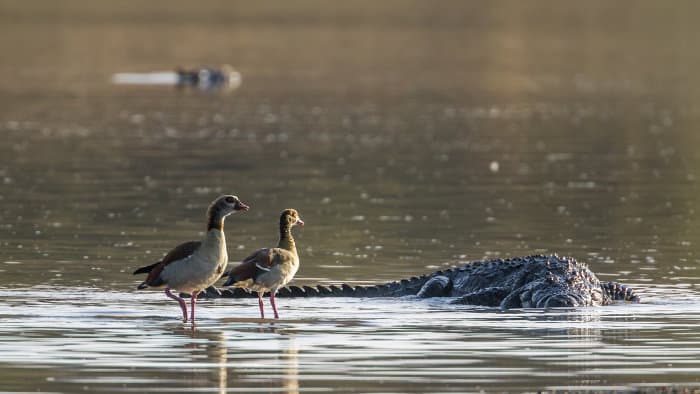
This reptile’s all-seeing orb can zoom in on any object of interest or concern, without needing the ability to clearly distinguish details or deep dimensions.
Crocodile eyes wouldn’t excel in any human eye test – mainly because the crocodile would choose to eat the optician before the test began – owing to the crocodile’s poor conventional powers of sight.
Though it can identify the various objects in its path, the crocodile struggles to see clear characteristics. Much of the distant landscape being a blur. A lack of depth perception is also an irritating issue for the long-tailed reptile.
However, crocodile eyes can take in the complete panorama in a single gaze. This is a huge advantage when hunting.
But how can the crocodile clearly catch everything going on within an almost 360-degree radius?
4. The Position of Crocodile Eyes
The position of crocodile eyes gives the impression of an optical illusion.
If you stand face to face (for those who are extremely stupid or suicidal), the eyes seem to be placed on the front and pointed forwards.
However, a side view of the crocodile’s cranium contradicts this. Even from the side continued eye contact is a possibility.
In addition to the chilling tendency of crocodile eyes to slide from front to side, following you wherever you go, check out the scientific inner structure of these sneaky snappers’ eyes.
5. Crocodile Eyelids

Crocodiles have thick, reinforced eyelids which serve as ample armour to protect against any aggressive attack from an angry assailant.
As if this weren’t enough, they can instinctively draw their eyeballs back into their sockets for further security.
One may think that one eyelid per eyeball was enough but not if you spend a significant portion of your day submerged in murky and muddy swamp water.
In the case of the crocodile, three certainly is the magic number. Not content with just one, the crocodile has a lower eyelid which in collaboration with the upper lid, securely sandwiches a third eyelid which has a very different duty.
6. Crocodile Eyes Have Built-In Goggles
The third centrally located eyelid takes the form of a clear membrane which serves as a pair of built-in goggles. The transparent film allows the crocodile to see underwater without getting any unwanted matter into its eyes.
As is the case when a human wears goggles to swim below the surface, the price paid for protected eyes is a blurry view of the obstacles and objects in the crocodile’s midst.
7. Crocodile Night Vision
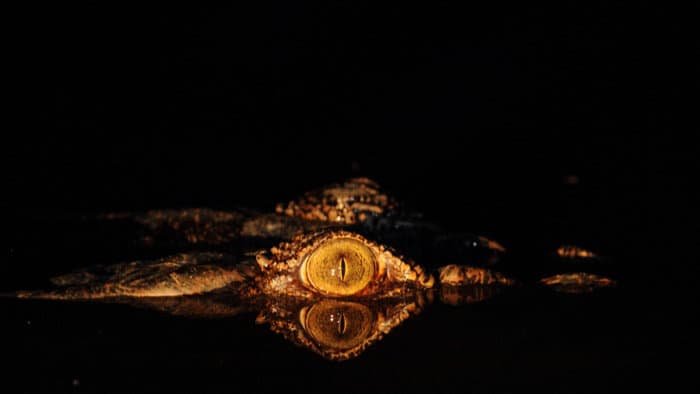
A new sight-related skill shines through after dark.
Microscopic crystals at the rear of each crocodile retina contain reflective mirrors. These are responsible for relaying incoming light during the day.
The pigment cells which make this possible are powered down at nightfall. Then the concealed crystal plates reflect light back onto the retina, which intensifies an image that might appear dull to a human eye.
The resulting shine that comes from the straightforward reflection forces the crocodile eyes to light up like a neon bulb and makes an already scary stalker look quite supernatural.
After dark, the crocodile has switched its underwater goggles for night-vision binoculars!
8. Crocodile Tears
Not known to the world as an openly emotional creature, you may be surprised to learn that the crocodile is partial to regular bouts of weeping.
It is a fact that crocodiles have been observed shedding more than a few tears when tearing into a tasty torso.
So, why do these monsters of the murky water cry when devouring their delicious dinner? Is it a result of reptilian regret? Are they torn up about the life they have taken? Not likely.
The crocodile’s habitual cry reflex is an involuntary biological behaviour. It is simply a symptomatic side-effect of the effort exerted when chomping and chewing.
The crocodile’s intense high-pitched hisses and huffs produce fluids, which froth and drip from the eye sockets. So crocodile tears are real…but only when they come from crocodile eyes.
9. Alligator vs Crocodile
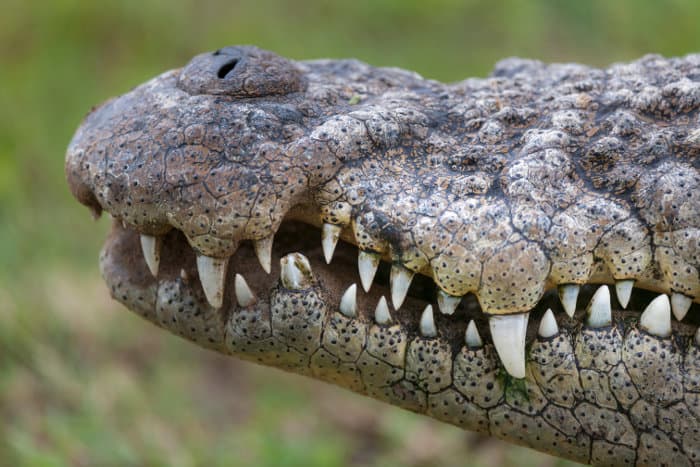
The quickest and easiest way to tell the difference between these two deadly creatures is the shape of the snout.
While alligators have a wide, rounded snout, resembling an oval dinghy, crocodiles have a narrow, elongated snout, similar to a kayak.
Both submersible species are longer than the average reptile, with crocodiles capable of reaching ridiculous lengths of 5.5 metres and alligators stretching a respectful 4 metres.
10. More Crazy Crocodile Facts
- The animal kingdom’s answer to the submarine, a crocodile can hold its breath underwater for up to an hour.
- A creature which is the coolest of customers, a crocodile cannot sweat.
- Crocodile hatchlings hitch a lift in their mother’s mouth!
Can You Look Crocodiles in the Eye?
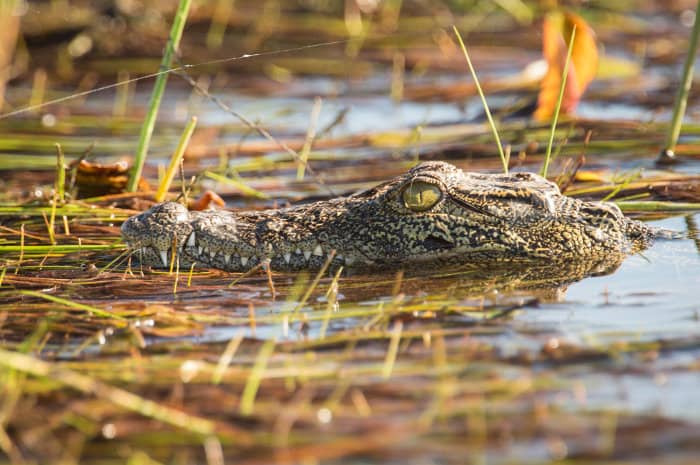
Crocodile eyes are remarkable works of nature, but don’t just take our word for it.
How about an Africa safari? So you can look crocodiles in the eye and wonder exactly what these magnificent reptiles can see about you.


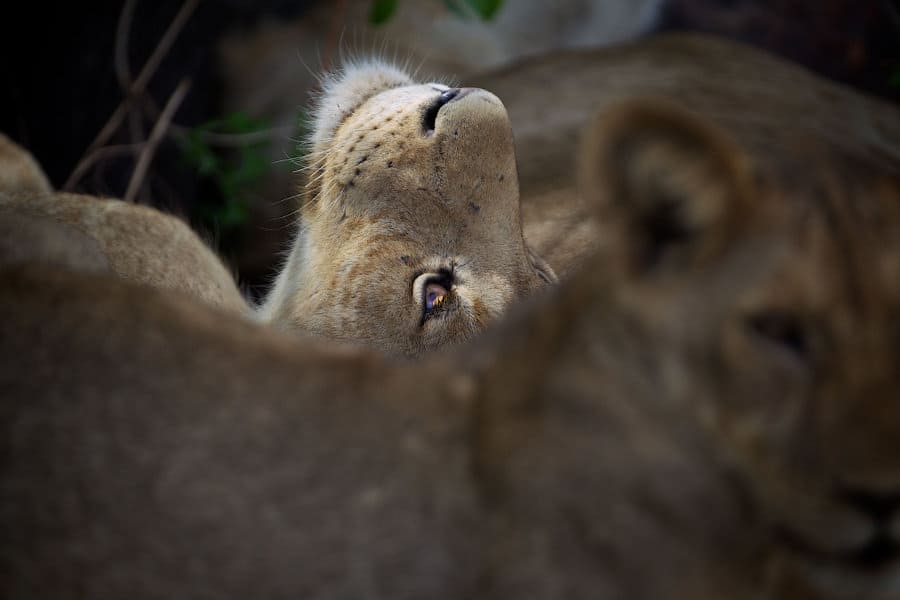

This is a fascinating article, and the magnified photos are great.
Happy you enjoyed it, Anita! 🙂
Take care,
Michael